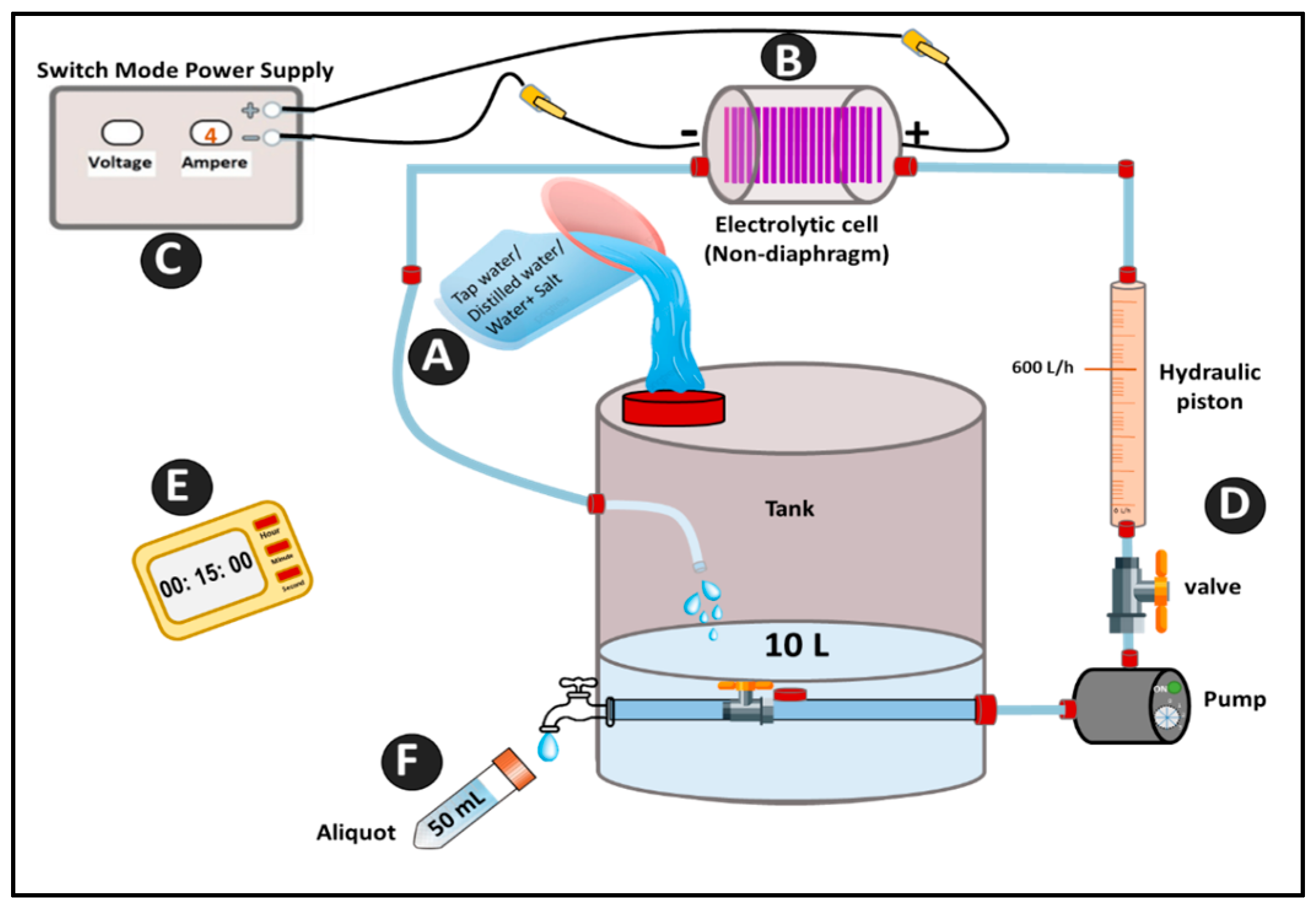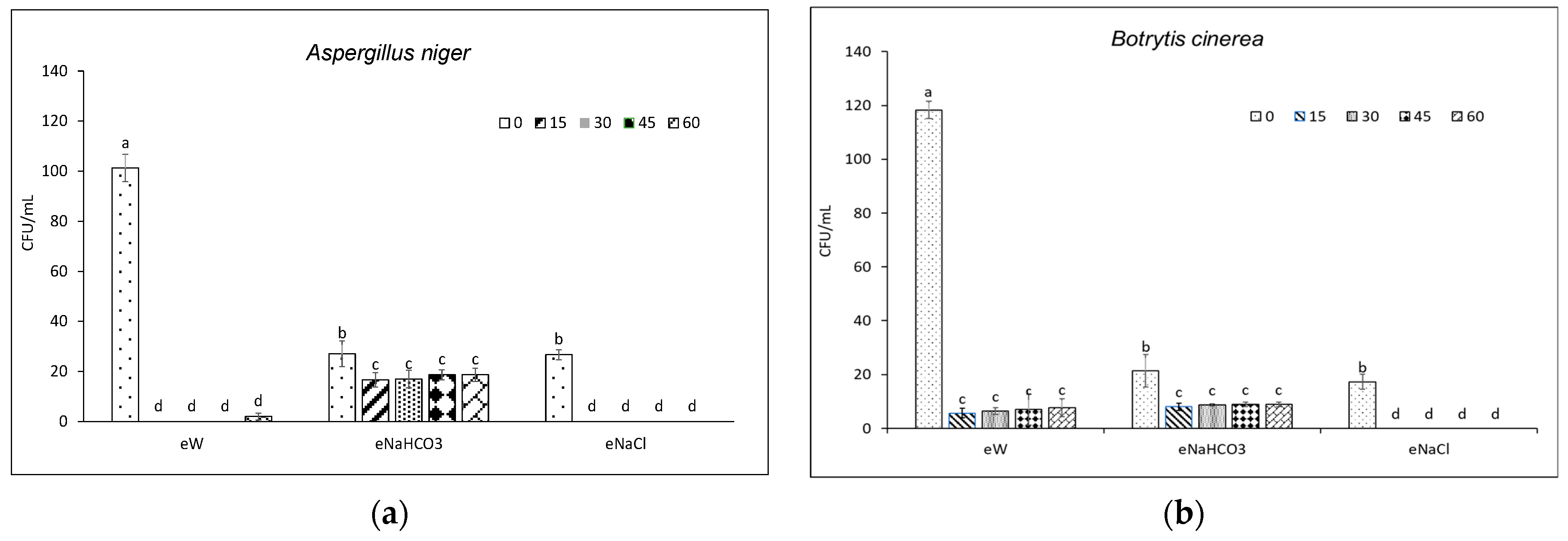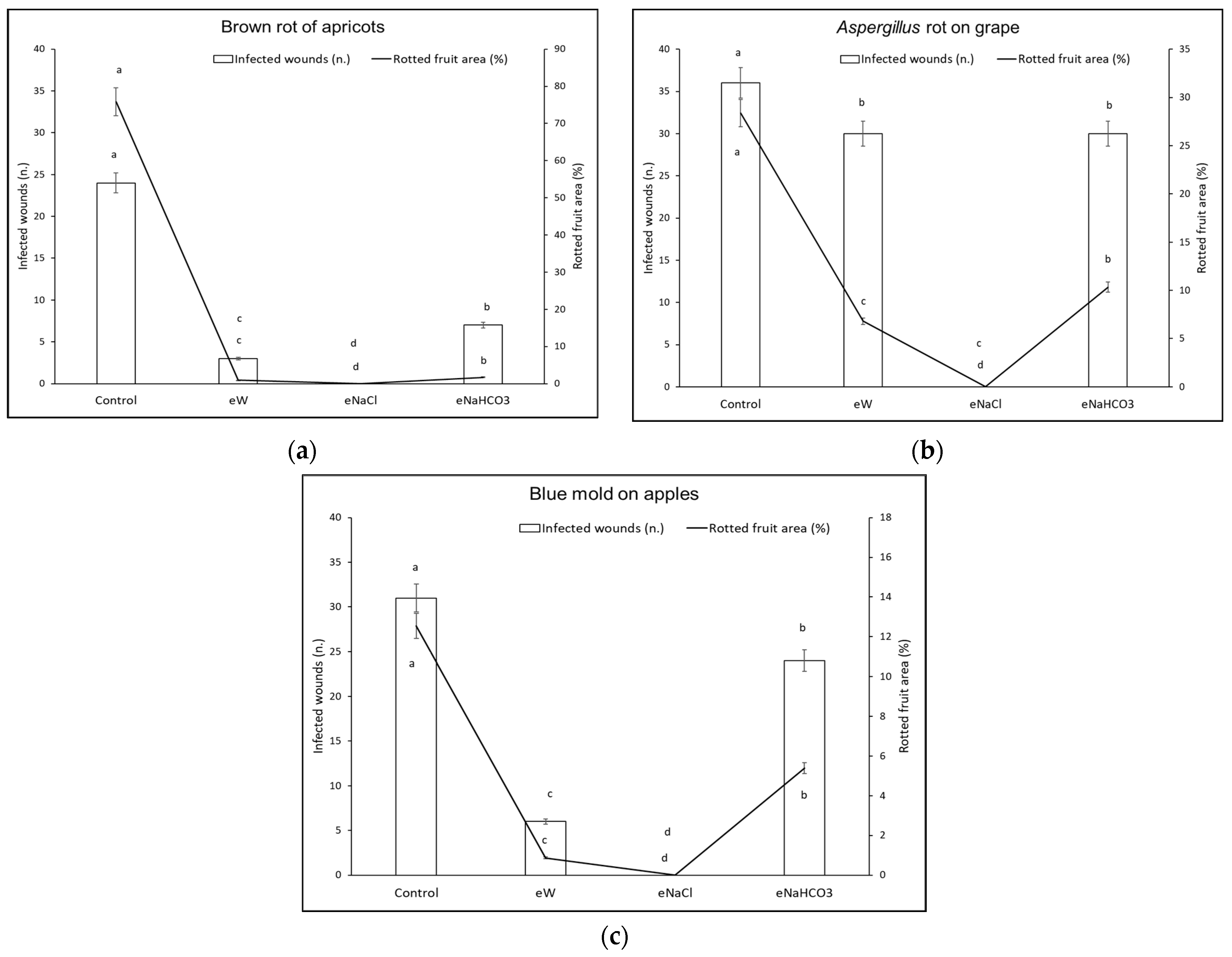Electrolyzed Salt Solutions Used against Major Postharvest Diseases of Fresh Fruit and Vegetables
Abstract
:1. Introduction
2. Results
2.1. Evaluation of the Effect of Electrolysis Treatments In Vitro
2.2. Chemical Analysis of Electrolyzed and Non-Electrolyzed Water
2.3. Evaluation of the Effect of Electrolysis Treatments In Vivo
3. Discussion
4. Materials and Methods
4.1. Electrolyzed Solution Preparation
4.2. Pathogen Inoculum
4.3. Measurement of Pathogen Conidia Viability and Growth In Vitro
4.4. Chemical Analysis of Electrolyzed and Non-Electrolyzed Water
4.5. Electrolyzed Water Treatment Effect In Vivo
4.6. Statistical Analysis
5. Conclusions
Author Contributions
Funding
Institutional Review Board Statement
Informed Consent Statement
Data Availability Statement
Conflicts of Interest
References
- Admane, N.; Cavallo, G.; Hadjila, C.; Cavalluzzi, M.M.; Rotondo, N.P.; Salerno, A.; Cannillo, J.; Difonzo, G.; Caponio, F.; Ippolito, A.; et al. Biostimulant Formulations and Moringa oleifera Extracts to Improve Yield, Quality, and Storability of Hydroponic Lettuce. Molecules 2023, 28, 373. [Google Scholar] [CrossRef]
- Li, B.; Zong, Y.; Du, Z.; Chen, Y.; Zhang, Z.; Qin, G.; Zhao, W.; Tian, S. Genomic characterization reveals insights into patulin biosynthesis and pathogenicity in Penicillium species. Mol. Plant-Microbe Interact. 2015, 28, 635–647. [Google Scholar] [CrossRef] [PubMed]
- Lafuente, M.T.; Zacarias, L. Postharvest physiological disorders in citrus fruit. Stewart Postharvest Rev. 2006, 2, 1–9. [Google Scholar] [CrossRef]
- Ferraz, P.; Cássio, F.; Lucas, C. Potential of yeasts as biocontrol agents of the phytopathogen causing cacao witches’ broom disease: Is microbial warfare a solution? Front. Microbiol. 2019, 10, 1766. [Google Scholar] [CrossRef] [PubMed]
- Fisher, M.C.; Hawkins, N.J.; Sanglard, D.; Gurr, S.J. Worldwide emergence of resistance to antifungal drugs challenges human health and food security. Science 2018, 360, 739–742. [Google Scholar] [CrossRef] [PubMed]
- Forghani, F. Application of electrolyzed water in agriculture. In Electrolyzed Water in Food: Fundamentals and Applications; Springer: Singapore, 2019; pp. 223–230. [Google Scholar] [CrossRef]
- Mansour, M.S.; Saber, M.M.; Ahmed, R.A.; Youssef, K. Biological, Chemical and Electrolyzed Water Methods for Controlling some Date Palm Diseases in Egypt. Egypt. J. Chem. 2023, 66, 1573–1582. [Google Scholar] [CrossRef]
- Feliziani, E.; Lichter, A.; Smilanick, J.L.; Ippolito, A. Disinfecting agents for controlling fruit and vegetable diseases after harvest. Postharvest Biol. Technol. 2016, 122, 53–69. [Google Scholar] [CrossRef]
- Fallanaj, F.; Sanzani, S.M.; Youssef, K.; Zavanella, C.; Salerno, M.G.; Ippolito, A. A new perspective in controlling postharvest citrus rots: The use of electrolyzed water. Acta Hortic. 2015, 1065, 1599–1605. [Google Scholar] [CrossRef]
- Zhang, W.; Cao, J.; Jiang, W. Application of electrolyzed water in postharvest fruits and vegetables storage: A review. Trends Food Sci. Technol. 2021, 114, 599–607. [Google Scholar] [CrossRef]
- Rahman, S.M.E.; Khan, I.; Oh, D.H. Electrolyzed water as a novel sanitizer in the food industry: Current trends and future perspectives. Compr. Rev. Food Sci. Food Saf. 2016, 15, 471–490. [Google Scholar] [CrossRef]
- Youssef, K.; Hussien, A. Electrolyzed water and salt solutions can reduce green and blue molds while maintain the quality properties of ‘Valencia’ late oranges. Postharvest Biol. Technol. 2020, 159, 111025. [Google Scholar] [CrossRef]
- Aday, M.S. Application of electrolyzed water for improving postharvest quality of mushroom. LWT 2016, 68, 44–51. [Google Scholar] [CrossRef]
- Hussien, A.; Ahmed, Y.; Al-Essawy, A.H.; Youssef, K. Evaluation of different salt-amended electrolyzed water to control postharvest moulds of citrus. Trop. Plant Pathol. 2018, 43, 10–20. [Google Scholar] [CrossRef]
- Shi, F.; Li, X.; Meng, H.; Wei, W.; Wang, Y. Reduction in chilling injury symptoms by hot electrolyzed functional water treatment may function by regulating ROS metabolism in Satsuma orange fruit. LWT 2020, 125, 109–218. [Google Scholar] [CrossRef]
- Qi, H.; Huang, Q.; Hung, Y.C. Effectiveness of electrolyzed oxidizing water treatment in removing pesticide residues and its effect on produce quality. Food Chem. 2018, 239, 561–568. [Google Scholar] [CrossRef] [PubMed]
- Fallanaj, F.; Sanzani, S.M.; Zavanella, C.; Ippolito, A. Salt addition improves the control of citrus postharvest diseases using electrolysis with conductive diamond electrodes. J. Plant Pathol. 2013, 95, 373–383. [Google Scholar]
- Sun, J.Z.; Jiang, X.J.; Chen, Y.H.; Lin, M.S.; Tang, J.Y.; Lin, Q.; Lin, H.T. Recent trends and applications of electrolyzed oxidizing water in fresh foodstuff preservation and safety control. Food Chem. 2022, 369, 130873. [Google Scholar] [CrossRef] [PubMed]
- Fallanaj, F.; Ippolito, A.; Ligorio, A.; Garganese, F.; Zavanella, C.; Sanzani, S.M. Electrolyzed sodium bicarbonate inhibits Penicillium digitatum and induces defence responses against green mould in citrus fruit. Postharvest Biol. Technol. 2016, 115, 18–29. [Google Scholar] [CrossRef]
- Hou, Y.T.; Ren, J.; Liu, H.J. Efficiency of electrolyzed water (EW) on inhibition of Phytophthora parasitica var. nicotianae growth in vitro. Crop Prot. 2012, 42, 128–133. [Google Scholar] [CrossRef]
- He, Y.; Zhao, X.; Chen, L.; Zhao, L.; Yang, H. Effect of electrolyzed water generated by sodium chloride combined with sodium bicarbonate solution against Listeria innocua in broth and on shrimp. Food Control 2021, 127, 108–134. [Google Scholar] [CrossRef]
- Palou, L.; Smilanick, J.L.; Usall, J.; Vinas, I. Control of postharvest decay blue and green molds of oranges by hot water, sodium carbonate and sodium bicarbonate. Plant Dis. 2001, 85, 371–376. [Google Scholar] [CrossRef] [PubMed]
- Sholberg, P.L.; Bedford, K.; Stokes, S. Sensitivity of Penicillium spp. and Botrytis cinerea to pyrimethanil and its control of blue and gray mold of stored apples. Crop Prot. 2005, 24, 127–134. [Google Scholar] [CrossRef]
- Villarreal-Barajas, T.; Vázquez-Durán, A.; Méndez-Albores, A. Effectiveness of electrolyzed oxidizing water on fungi and mycotoxins in food. Food Control 2022, 131, 108454. [Google Scholar] [CrossRef]
- Waters, B.W.; Hung, Y.C. The effect of pH and chloride concentration on the stability and antimicrobial activity of chlorine-based sanitizers. J. Food Sci. 2014, 79, M622–M627. [Google Scholar] [CrossRef] [PubMed]
- Vylkova, S. Environmental pH modulation by pathogenic fungi as a strategy to conquer the host. PLoS Pathog. 2017, 13, e1006149. [Google Scholar] [CrossRef] [PubMed]
- Youssef, K.; Sanzani, S.M.; Ligorio, A.; Ippolito, A.; Terry, L.A. Sodium carbonate and bicarbonate treatments induce resistance to postharvest green mould on citrus fruit. Postharvest Biol. Technol. 2014, 87, 61–69. [Google Scholar] [CrossRef]
- Al-Haq, M.I.; Seo, Y.; Oshita, S.; Kawagoe, Y. Fungicidal effectiveness of electrolyzed oxidizing water on postharvest brown rot of peach. HortScience 2001, 36, 1310–1314. [Google Scholar] [CrossRef]
- Al-Haq, M.I.; Seo, Y.; Oshita, S.; Kawagoe, Y. Disinfection effects of electrolyzed oxidizing water on suppressing fruit rot of pear caused by Botryosphaeria berengeriana. Food Res. Int. 2002, 35, 657–664. [Google Scholar] [CrossRef]
- Audenaert, K.; Monbaliu, S.; Deschuyffeleer, N.; Maene, P.; Vekeman, F.; Haesaert, G.; De Saeger, S.; Eeckhout, M. Neutralized electrolyzed water efficiently reduces Fusarium spp. in vitro and on wheat kernels but can trigger deoxynivalenol (DON) biosynthesis. Food Control 2012, 23, 515–521. [Google Scholar] [CrossRef]
- Guentzel, J.L.; Lam, K.L.; Callan, M.A.; Emmons, S.A.; Dunham, V.L. Postharvest management of gray mold and brown rot on surfaces of peaches and grapes using electrolyzed oxidizing water. Int. J. Food Microbiol. 2010, 143, 54–60. [Google Scholar] [CrossRef]
- Okull, D.O.; Laborde, L.F. Activity of electrolyzed oxidizing water against Penicilium expansum in suspension and on wounded apples. J. Food Sci. 2004, 69, FMS23–FMS27. [Google Scholar] [CrossRef]
- Vásquez-López, A.; Villarreal-Barajas, T.; Rodríguez-Ortiz, G. Effectiveness of neutral electrolyzed water on incidence of fungal rot on tomato fruits (Solanum lycopersicum L.). J. Food Prot. 2016, 79, 1802–1806. [Google Scholar] [CrossRef] [PubMed]
- Whangchai, K.; Saengnil, K.; Singkamanee, C.; Uthaibutra, J. Effect of electrolyzed oxidizing water and continuous ozone exposure on the control of Penicillium digitatum on tangerine cv. ‘Sai Nam Pung’ during storage. Crop Prot. 2010, 29, 386–389. [Google Scholar] [CrossRef]
- Brauns, J.; Turek, T. Alkaline water electrolysis powered by renewable energy: A review. Processes 2020, 8, 248. [Google Scholar] [CrossRef]
- Wang, M.; Wang, Z.; Gong, X.; Guo, Z. The Intensification Technologies to Water Electrolysis for Hydrogen Production—A Review. Renew. Sustain. Energy Rev. 2014, 29, 573–588. [Google Scholar] [CrossRef]
- Liu, L.; Yang, S.; Chen, C.; Fang, Y.; Li, L.; Ban, Z. High-performance films fabricated by food protein nanofibrils loaded with vanillin: Mechanism, characterization and bacteriostatic effect. Food Packag. Shelf Life 2023, 37, 101080. [Google Scholar] [CrossRef]






| Time (min) | Free Chlorine (mg/L) | pH | Conductivity (µS/cm) | |
|---|---|---|---|---|
| eW | 0 | 0.73 | 7.9 | 2250 |
| 15 | 1.00 | 7.8 | 3370 | |
| 30 | 1.90 | 7.6 | 3980 | |
| 45 | 1.96 | 7.7 | 4327 | |
| 60 | 1.96 | 7.8 | 5160 | |
| eNaCl | 0 | 1.75 | 7.8 | 15,220 |
| 15 | 2.20 | 7.9 | 17,995 | |
| 30 | 3.3 | 8.2 | 19,725 | |
| 45 | 3.5 | 8.2 | 21,350 | |
| 60 | 3.5 | 8.3 | 21,700 | |
| eNaHCO3 | 0 | 0.47 | 8.3 | 6556 |
| 15 | 0.32 | 8.6 | 5365 | |
| 30 | 0.27 | 8.4 | 6394 | |
| 45 | 0.24 | 8.5 | 8383 | |
| 60 | 0.22 | 8.7 | 8500 |
Disclaimer/Publisher’s Note: The statements, opinions and data contained in all publications are solely those of the individual author(s) and contributor(s) and not of MDPI and/or the editor(s). MDPI and/or the editor(s) disclaim responsibility for any injury to people or property resulting from any ideas, methods, instructions or products referred to in the content. |
© 2024 by the authors. Licensee MDPI, Basel, Switzerland. This article is an open access article distributed under the terms and conditions of the Creative Commons Attribution (CC BY) license (https://creativecommons.org/licenses/by/4.0/).
Share and Cite
Hadjila, C.; Incerti, O.; Celano, G.; Desopo, M.; Ippolito, A.; Sanzani, S.M. Electrolyzed Salt Solutions Used against Major Postharvest Diseases of Fresh Fruit and Vegetables. Foods 2024, 13, 2503. https://doi.org/10.3390/foods13162503
Hadjila C, Incerti O, Celano G, Desopo M, Ippolito A, Sanzani SM. Electrolyzed Salt Solutions Used against Major Postharvest Diseases of Fresh Fruit and Vegetables. Foods. 2024; 13(16):2503. https://doi.org/10.3390/foods13162503
Chicago/Turabian StyleHadjila, Chahinez, Ornella Incerti, Giuseppe Celano, Marika Desopo, Antonio Ippolito, and Simona Marianna Sanzani. 2024. "Electrolyzed Salt Solutions Used against Major Postharvest Diseases of Fresh Fruit and Vegetables" Foods 13, no. 16: 2503. https://doi.org/10.3390/foods13162503






